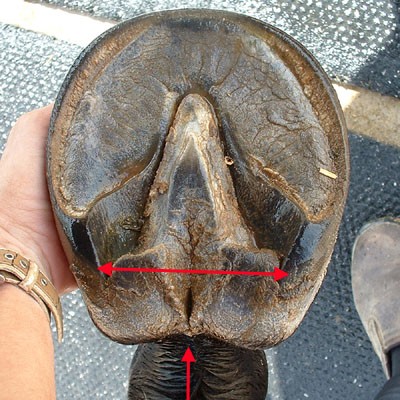Here is a very contracted hoof:

A hoof is very contracted when the overall shape is long and narrow, the heel purchase areas are close together (top arrows) and the heel bulbs are close together and form a deep pucker that looks like butt-cheeks (bottom arrow). Some horses have a wide middle to their hoof, yet have the heel purchases close together; that is usually referred to as “heel contraction.” The majority of horses with contacted hooves have some contraction in all areas.
This hoof may look like a drastic example of contraction, but is pretty typical of the appearance of most hooves upon removing the horse’s shoes. You can even see examples of similarly contracted hooves proudly displayed in magazine ads, catalogs, and photo closeups of top competition and even Olympic-level horses. Surprisingly, to many people this hoof looks totally normal. This is not normal, this is pathological.
This hoof is very unhealthy, due to the diminished blood flow inside the hoof, and the deformity of the internal hoof structures. This horse is most likely lame (meaning he cannot walk barefoot upon the ground comfortably and heel-first). Even if he is not yet showing lameness or other symptoms, he has probably begun the changes towards both navicular syndrome and founder. These changes don’t happen quickly, they happen slowly – a degeneration over the years – further exacerbated by any treatment that alleviates the pain (shoeing, pads, drugs, etc.) but fails to recognize and remedy the cause of the problem: the contraction of the hoof.
Here is a normal, healthy hoof that is not contracted:

This hoof belongs to a horse that has never worn shoes. This hoof is round, equal width and length. Notice how far apart the heel purchase areas are (top arrows) and how far apart the heel bulbs are. Notice the wide spaces (bottom arrow) in between the two heel bulb points – no resemblance to butt-cheeks!
This is a healthy hoof that is not contracted. ALL HOOVES should look similar to this, with the above-mentioned features. This is what constitutes a healthy, functioning equine hoof, as defined by nature, not by man.


A contracted hoof, and a normal, healthy hoof.
Shari Murray

Customer Service
If you call the customer service help desk, you’ll probably get me on the phone! I process repairs, returns, credits and exchanges that come into EasyCare.





Yes, horses heel can get contracted while being barefoot. There are several possible reasons for that:
-A horse could be heel or frog sore and reluctant to bear weight over the heels. Check for sensitive frog and heel buttress with hoof tester
-Contracted heels can also be a symptom for navicular disease. Check for navicular sensitivity.
-Lack of moisture in the hoof can cause contraction. Use poultice boot or let horse stand on moist ground or water. Apply hoof dressing to keep moisture within the hoof.
-Contracted heels can also be genetic. Normally if two pairs of recessive genes are present. There is very little one can do about genes, just more frequent trimming and keeping the hoof as moist a possible.
My horse has been barefoot for nearly 2 years now, and she gets trimmed regularly, however, I am not sure if she is starting to show contracted heels, can you please tell me if a horse can get contracted heels while being barefoot, or is it just a bad shoeing thing?
love it! everyone must be able to see that difference, side by side. . . really great, thanks from all the horses with heel pain!
Comments are closed.